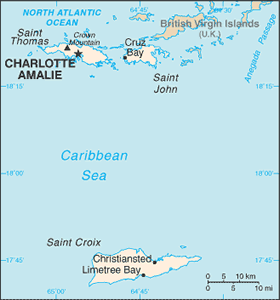The Geography of Virgin Islands
The Geography of Virgin Islands
Virgin Islander Geography
Location: Caribbean, islands between the Caribbean Sea and the North Atlantic Ocean, east of Puerto Rico
Geographic coordinates: 18 20 N, 64 50 W
Map references: Central America and the Caribbean
Area: total: 1,910 sq km land: 346 sq km water: 1,564 sq km
Area - comparative: twice the size of Washington, DC
Land boundaries: 0 km
Coastline: 188 km
Maritime claims: territorial sea: 12 nm exclusive economic zone: 200 nm
Climate: subtropical, tempered by easterly trade winds, relatively low humidity, little seasonal temperature variation; rainy season September to November
Terrain: mostly hilly to rugged and mountainous with little level land
Elevation extremes: lowest point: Caribbean Sea 0 m highest point: Crown Mountain 475 m
Natural resources: sun, sand, sea, surf
Land use: arable land: 5.71% permanent crops: 2.86% other: 91.43% (2005)
Irrigated land: NA
Natural hazards: several hurricanes in recent years; frequent and severe droughts and floods; occasional earthquakes
Environment - current issues: lack of natural freshwater resources
Environment - international agreements:
Geography - note: important location along the Anegada Passage - a key shipping lane for the Panama Canal; Saint Thomas has one of the best natural deepwater harbors in the Caribbean


